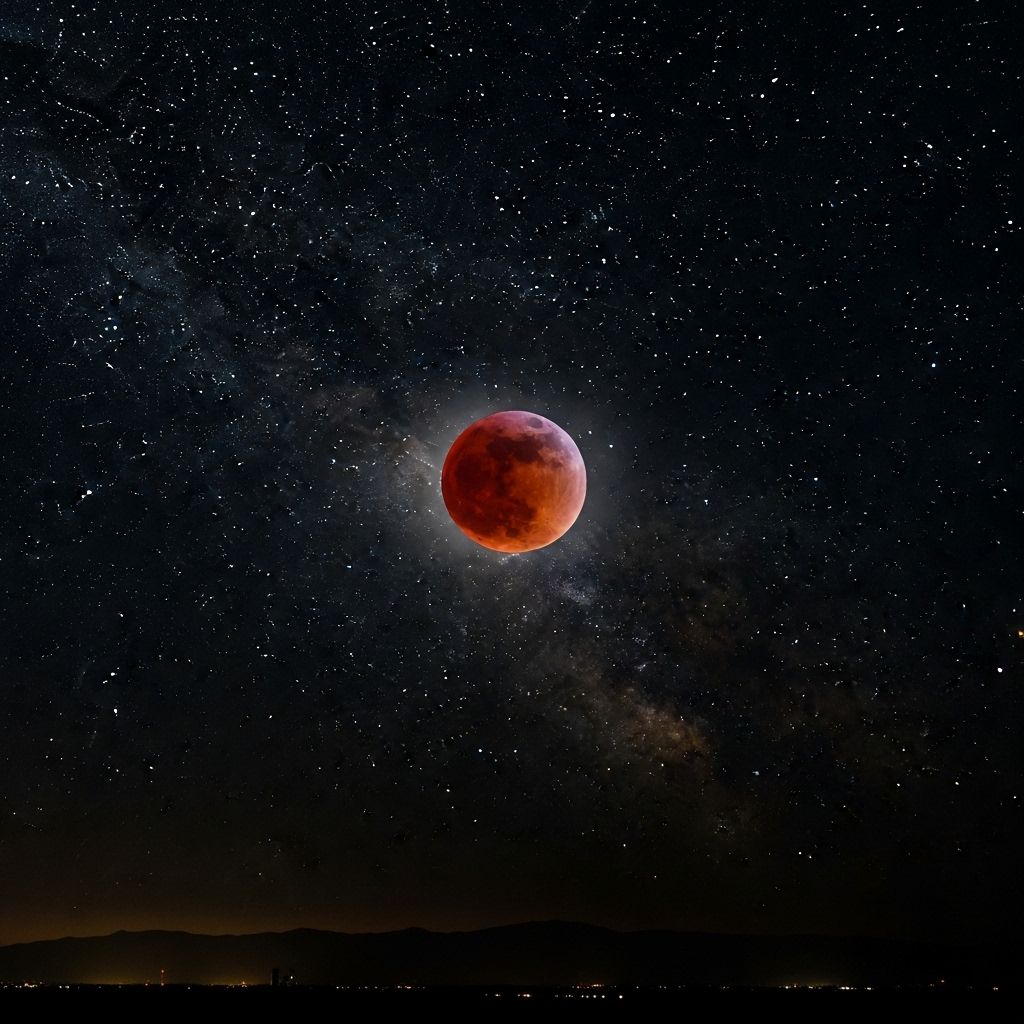Lunar Eclipse Complete Guide: How To Observe And Enjoy In 2025
Everything you need to know to observe, understand, and photograph a lunar eclipse.

Image: HearthJunction Design Team
Lunar Eclipses: Nature’s Celestial Spectacle
Lunar eclipses are among the most dramatic and accessible astronomical events visible from Earth. Unlike solar eclipses, which require eye protection and are only seen from specific locations, lunar eclipses are visible from anywhere the moon is above the horizon during the event. Whether you’re a seasoned skywatcher or just beginning your journey into astronomy, this comprehensive guide will help you understand, observe, and enjoy lunar eclipses to the fullest.
What is a Lunar Eclipse?
A lunar eclipse occurs when the Earth passes directly between the sun and the moon, casting a shadow that envelops the moon. As the moon moves through Earth’s shadow, it can take on a variety of colors, from deep copper red to subtle gray. These stunning changes in appearance are the result of Earth’s atmosphere filtering and refracting sunlight, scattering the shorter blue wavelengths and allowing the longer red wavelengths to reach the moon’s surface.
- Penumbral Eclipse: The moon only passes through the faint outer part of Earth’s shadow (the penumbra). This subtle shading is often hard to notice with the naked eye.
- Partial Eclipse: Part of the moon moves through the Earth’s darker central shadow (the umbra), causing a dramatic dark ‘bite’ to be taken from the lunar disc.
- Total Eclipse: The entire moon passes through the umbra, often turning a deep red or orange, known as a “blood moon.”
How Do Lunar Eclipses Occur?
Lunar eclipses happen only during a full moon, when the Sun, Earth, and Moon are aligned in a straight line (syzygy). However, because the Moon’s orbit is slightly tilted relative to Earth’s orbit around the Sun, eclipses do not occur every month but only when the alignment is precise.
The Mechanics of an Eclipse
- During a penumbral eclipse, the moon passes through Earth’s penumbral shadow, causing a gentle dimming.
- In a partial lunar eclipse, a portion of the moon enters the central, dark umbra, resulting in a distinct shadow covering part of the lunar face.
- A total lunar eclipse is achieved when the moon is completely within the umbra, often glowing red due to atmospheric filtering.
Upcoming Lunar Eclipses: 2025 and Beyond
Excited to catch a lunar eclipse? Mark your calendar for these upcoming events:
- March 13-14, 2025: This total lunar eclipse will be visible primarily across North and South America, offering a full view of the spectacular totality phase.
- September 7, 2025: This total lunar eclipse can be observed from Asia and Western Australia, from start to finish.
Because lunar eclipses are visible to anyone on the nighttime side of Earth, check your local times to see if the eclipse will be visible in your area. Remember, weather and atmospheric conditions may affect visibility.
Viewing Times for March 2025 Total Lunar Eclipse
| Region | Time of Totality (start – end) |
|---|---|
| Eastern (ET) | 2:26 a.m. – 3:31 a.m. (March 14) |
| Central (CT) | 1:26 a.m. – 2:31 a.m. (March 14) |
| Mountain (MT) | 12:26 a.m. – 1:31 a.m. (March 14) |
| Pacific (PT) | 11:26 p.m. (March 13) – 12:31 a.m. (March 14) |
| Alaska (AK) | 10:26 p.m. – 11:31 p.m. (March 13) |
| Hawaii (H) | 8:26 p.m. – 9:31 p.m. (March 13) |
Step outside at least 10–15 minutes before and after these times to witness the moon’s gradual entry and exit from Earth’s shadow, maximizing your eclipse experience.
How to Observe a Lunar Eclipse
Observing a lunar eclipse is simple and does not require any specialized equipment. Here’s how to make the most of the experience:
- Find a Clear, Dark Location: Choose a location far from city lights with an unobstructed view of the sky. Parks, fields, or open backyards are ideal.
- No Eye Protection Needed: Unlike solar eclipses, lunar eclipses are safe to observe with the naked eye.
- Optional Equipment: While no equipment is necessary, binoculars or a small telescope can enhance details on the lunar surface.
- Comfort First: Lunar eclipses can last several hours. Bring comfortable chairs, warm clothes, blankets, and hot drinks—especially if viewing in winter.
- Photography: For those interested in capturing the event, use a tripod-mounted camera with a telephoto lens. Experiment with different settings to photograph the various stages of the eclipse.
Expert Tips for Skywatchers
Veteran eclipse chasers recommend these best practices for an optimal viewing experience:
- Arrive at your viewing location early to allow your eyes to adjust to the darkness.
- Use a star chart or skywatching app to locate the moon and track its position during the eclipse.
- If the weather is cloudy or hazy, try changing locations for a clearer view, if possible.
The Science Behind the Colors
During totality, the moon often turns a coppery red or orange due to Rayleigh scattering. Earth’s atmosphere scatters the shorter blue wavelengths, allowing primarily red wavelengths to pass through and illuminate the moon even while it sits in Earth’s shadow. This is similar to why sunsets and sunrises appear red.
The exact shade of the moon during totality can vary depending on atmospheric conditions, such as dust, clouds, or volcanic ash in the air. Sometimes the eclipse will be a dark brown or gray instead of the expected red.
Lunar Eclipse vs. Solar Eclipse
| Aspect | Lunar Eclipse | Solar Eclipse |
|---|---|---|
| Occurrence | Full moon (Earth between sun and moon) | New moon (Moon between sun and Earth) |
| Visibility | Any location with moon above horizon | Narrow path (total/partial phase), specific areas |
| Eye Safety | Safe to view with naked eye | Eye protection required |
| Frequency | 1–3 times per year | 2–5 times per year (all types) |
| Color Effects | Moon can appear red (blood moon) | Day turns to night; dramatic sun corona |
Common Phenomena and What to Watch For
- Partial Phases: Watch as Earth’s shadow slowly advances across the lunar surface, creating a dramatic dark ‘bite.’
- Totality: The moon glows in shades of orange, copper, and red. This phase can last over an hour.
- Emergence: The moon exits Earth’s shadow, brightening back to its usual silvery hue.
- Stars Appear: As the moon dims during totality, fainter stars normally hidden by moonlight become visible.
Capturing the Moment: Photographing a Lunar Eclipse
Astrophotography enthusiasts can document the beauty of a lunar eclipse with some preparation:
- Use a sturdy tripod to avoid camera shake. A remote shutter release or camera timer is also helpful.
- Choose a telephoto lens (at least 200mm) for close-up lunar shots, or a wider lens for including landscape elements.
- Start with an ISO setting of 200–800, f/8 aperture, and vary the shutter speed (e.g., 1/125s for partial phases, longer for totality).
- Bracket exposures: Take multiple shots with different settings to ensure you capture the moon’s details throughout the eclipse.
- Experiment with composite images to show the eclipse stages in a single frame.
Historical and Cultural Significance
Throughout history, lunar eclipses have been cause for awe, wonder, and sometimes fear. Ancient cultures across the globe recorded these events, often attributing them to supernatural causes or omens. Modern science has demystified the phenomenon, yet the sense of wonder remains every time Earth’s shadow transforms the moon.
Frequently Asked Questions (FAQs)
Q: When is the next lunar eclipse?
A: The next total lunar eclipse will occur on March 13–14, 2025, followed by another on September 7, 2025.
Q: Is it safe to look at a lunar eclipse?
A: Yes, observing a lunar eclipse is completely safe with the naked eye, binoculars, or a telescope.
Q: What makes the moon turn red during an eclipse?
A: The reddish color during totality is caused by Earth’s atmosphere filtering and scattering sunlight, allowing only red wavelengths to reach and illuminate the moon.
Q: Do I need any equipment to see a lunar eclipse?
A: No equipment is required, but binoculars or a telescope can enhance your view.
Q: Will I be able to see the whole eclipse from my location?
A: If the moon is above the horizon during the eclipse in your location and the sky is clear, you’ll be able to see it. Check local times for visibility.
Final Thoughts: Don’t Miss the Show!
Lunar eclipses are one of the most accessible and beautiful astronomical events, offering everyone a front-row seat to the dynamic relationship between the Earth, moon, and sun. With just a bit of preparation and a clear sky, anyone can enjoy the spectacle—no fancy equipment required. Next time a lunar eclipse graces the night sky, step outside, look up, and enjoy the cosmic performance unfolding above you.
References
- https://www.space.com/33786-lunar-eclipse-guide.html
- https://www.space.com/15689-lunar-eclipses.html
- https://www.space.com/total-lunar-eclipse-one-week-away-march-2025-everything-you-need-to-know
- https://www.space.com/4952-viewer-guide-total-lunar-eclipse-feb-20.html
- https://www.space.com/30656-total-lunar-eclipse-supermoon-viewing-guide.html
Read full bio of Srija Burman











